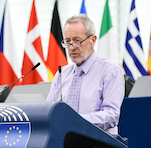
Empowering Europe’s Tomorrow: Driving the Transition to a Green Hydrogen Economy
The European Union has set ambitious targets to combat climate change, aiming to drive an ambitious systemic change in how we produce, consume and store energy. It is clear that addressing sustainability challenges and climate change will be central to the future growth of our economy, as the cost of inaction now will be far exceeded by the costs involved with adaptation, never mind the social and political instability this would create.
To achieve these goals, we need a transformation of the energy sector, an energy efficient building stock, more circular production and consumption as well as decarbonizing our industries.
Ireland has some of the best renewable resources in the world, but we have not yet realised our enormous potential. With the right European level strategy, Ireland can become a vital source of renewable electricity for the entire continent, ending Europe’s dependency on Russia and driving down costs for businesses and citizens.
Irish wind, solar and green hydrogen, with the right plan, can decarbonise and power homes and businesses right across Europe.
At the same time, this will drive enormous investment into Ireland’s coastal and rural communities, creating tens of thousands of jobs as we construct and operate renewable energy projects at a continental scale in Irish waters.
Hydrogen is enjoying a renewed and rapidly growing attention in Europe and around the world. However, hydrogen currently represents a modest fraction of the global and EU energy mix, and is still largely produced from fossil fuels, notably from natural gas or from coal.
Hydrogen can have an important role in our transition to a carbon-neutral European economy, playing a key role in decarbonising those sectors that are more challenging to electrify, such as certain heavy industries and aviation, and providing important long duration storage and flexibility services to a renewable-powered grid, enabling us to move to a truly zero-carbon electricity system. However, we must ensure that the hydrogen we use to decarbonise these sectors is green hydrogen – produced exclusively from our vast renewable resources.
In transport, for example, hydrogen fuel cells offer an efficient and emissions-free alternative to internal combustion engines of larger vehicles, with the added benefit of faster refuelling times and longer ranges.
In industry, green hydrogen can replace fossil fuels as a feedstock for processes such as steel and cement production, dramatically reducing carbon emissions.
The successful delivery of our 2050 goals hinges on the delivery of a fully decarbonised electricity system in the middle of the 2030s. To do this, we need to urgently and rapidly support the development long duration energy storage technologies and build on the successful integration of zero-carbon system services and shorter duration battery storage technologies we have seen in recent years.
Alongside other promising new technologies, Green Hydrogen can be an important part of this solution. It can enable us to bulk time-shift variable renewable energy production, helping us to match variable renewable generation with times of high demand, and providing a solution to the so-called dunkelflaute problem when we have long periods with low levels of wind and solar generation.
In my view, the key challenge for the EU’s 2040 framework will be integrating vast quantities of long-duration storage technologies in a manner that is cost effective for citizens. This needs to be a priority for the incoming Energy Commissioner.
The economic opportunities presented by the development of a green hydrogen economy are equally compelling. By investing in the production, storage, and distribution infrastructure for green hydrogen, Europe can create high-quality jobs, stimulate innovation, and enhance its global competitiveness. Moreover, by reducing our dependence on imported fossil fuels and promoting energy independence, green hydrogen can enhance Europe’s geopolitical resilience and security.
There are a number of exciting new green hydrogen projects being developed across the island of Ireland, and industrious example of a small community seeking to produce hydrogen for their own use can be found on the beautiful Valentia island off the coast of County Kerry. I have taken great pleasure visiting this project and I hope to do the same for many more projects to come.
However, this is just a drop in the ocean, and if we are serious about any of this, we really need to get a move on. To help us achieve it, I am calling on the European Commission to take a number of steps.
Firstly, we need to set out a new spatial strategy, identifying the areas best suited to develop renewables and storage at scale.
This strategy should prioritize regions with abundant renewable resources, so that wind, solar and long-duration storage technologies (including green hydrogen) can be developed economically.
Secondly, it is vital that we launch a new EU Renewable Energy Fund to support these projects from a central European support scheme.
The purpose of this fund would be to provide CAPEX and OPEX support to key projects of common European interest, recognising that their crossborder nature and value to the EU as a whole means that the cost of supporting them should not fall solely on the citizens of any single Member State.
Finally, we must ensure accelerated planning permission for the renewable and grid projects that form part of this strategy.
Delays in obtaining permits and approvals can significantly hinder the timely implementation of renewable energy projects, undermining our efforts to transition to a green hydrogen economy. There is no place more suited for this than Ireland, with its vast renewable energy potential and strategic geographic location. However, realizing this potential requires a clear strategy and political impetus to streamline regulatory processes and facilitate project development.
By implementing these measures, we can accelerate the transition to a green hydrogen economy and unlock the full potential of renewable energy resources across Europe. The time for bold and decisive action is now, and I urge the European Commission to seize this opportunity to lead the way towards a more sustainable future for all.




